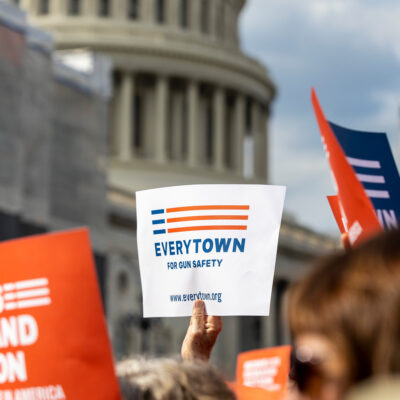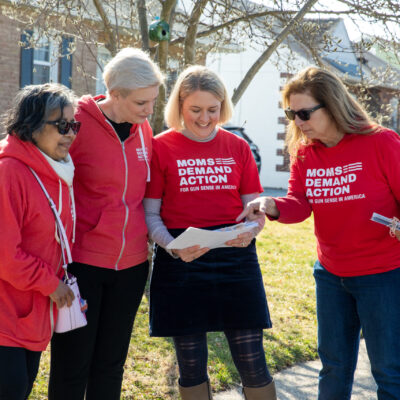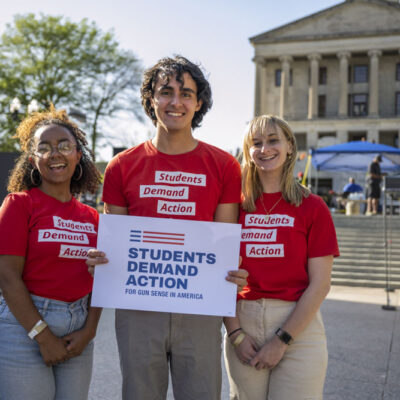New Report from Everytown and the Nevada Network Against Domestic Violence Finds Nevada Women Are 65 Percent More Likely to be Shot to Death by Intimate Partners Than Women Nationwide
4.13.2016
RENO AND NEW YORK RENO AND NEW YORK – The Everytown for Gun Safety Support Fund and the Nevada Network Against Domestic Violence (NNADV) today released a new report, “A Census of Intimate Partner Gun Homicides in Nevada,” that finds women in Nevada are 65 percent more likely to be shot to death by their current or former intimate partners than women nationwide. The report (available here) identifies 46 intimate partner gun homicides in Nevada between 2010 and 2014. Based on an analysis of FBI data, the reports finds that Nevada has the fifth highest rate of domestic violence gun homicide of women in any state. – The Everytown for Gun Safety Support Fund and the Nevada Network Against Domestic Violence (NNADV) today released a new report, “A Census of Intimate Partner Gun Homicides in Nevada,” that finds women in Nevada are 65 percent more likely to be shot to death by their current or former intimate partners than women nationwide. The report (available here) identifies 46 intimate partner gun homicides in Nevada between 2010 and 2014. Based on an analysis of FBI data, the reports finds that Nevada has the fifth highest rate of domestic violence gun homicide of women in any state.
“Our research shows undeniable proof that in many of these cases, there were ample indications that the shooters posed a risk to their partners – and that some of these tragedies could have been avoided if stronger laws had been in place to protect Nevada women,” said Sarah Tofte, deputy research director for Everytown for Gun Safety. “For example at least one in four shooters had a criminal record that prohibited them from having a gun legally, but they were able to get firearms because of loopholes in Nevada law, including through unlicensed gun sales. The data shines a light on the elevated rates of intimate partner gun violence in Nevada, but they also show how stronger laws can reduce gun violence and save lives.”
“For years, we have been working to reduce Nevada’s alarming rate of intimate partner violence and its effect on families, children and our communities. This research illustrates the true extent of this violence, and it should compel all of us to work together to put solutions in place,” said Sue Meuschke, executive director of the Nevada Network Against Domestic Violence (NNADV). “As a start, it is imperative that Nevada close the existing loopholes in our state gun laws and take steps to protect victims of domestic violence and their children. The evidence in this report that supports the need for greater protections is overwhelming and should send a strong message to all Nevadans that we must take action.”
“The toll of domestic violence shootings is far worse than many people realize. These incidents devastate the families and children of women killed by their abusers – many of whom witness the shootings or are left behind,” said Mechele Lavoll, whose 22-year-old daughter, Brittney Lavoll, who was shot and killed by the father of two of her children on March 25, 2010. “My daughter was taken from me by a man who should never have had a gun. My grandchildren’s mother was stolen from them. No parent should have to bury her child, and no children should have to grow up without their mother.”
Last year, Nevada enacted laws prohibiting gun possession by convicted abusers. However, state law does not require that domestic abusers who become prohibited surrender the guns already in their possession, nor does it require criminal background checks for all gun sales. These loopholes allow abusers to retain illegal access to the guns they already own and make it easy for prohibited individuals to purchase guns through unlicensed sales.
Key findings:
- Women in Nevada are 65 percent more likely to be shot to death by intimate partners than women nationwide, according to an analysis of FBI data. In fact, Nevada has the fifth highest rate of intimate partner gun homicides of any state in the country.
- Everytown and NNADV identified 46 intimate partner gun homicides in Nevada over the five-year period. During the incidents, abusers also shot 10 additional victims — friends, family members, and children — killing six of them, two of whom were children.
- There were ample indications prior to the shootings that the abusers posed a risk to their partners. More than one in four shooters had a criminal record that prohibited them from possessing firearms — the majority due to prior domestic violence crimes.
- Of six homicides committed by people barred from possessing firearms where the source of the gun could be determined, two got their guns in unlicensed sales.
- In addition to those killed or injured, at least 20 children witnessed or were present for the shootings. In fact, at least 39 percent of the homicides took place in the presence of other people, demonstrating the devastating impact these homicides had on the children, families, and community members present during the shootings.
- After killing their intimate partners, nearly two-thirds of the abusers killed themselves, all but one with a firearm.
These findings suggest Nevada should enact the following laws:
Additional information about intimate partner gun homicides:
- Require criminal background checks for all gun sales;
- Prohibit all domestic abusers with misdemeanor domestic violence convictions, stalking convictions, or active extended orders of protection from buying or possessing firearms; and
- Ensure that all domestic abusers and stalkers who become prohibited from possessing guns surrender the firearms already in their possession.
- In states that require background checks for all handgun sales, there are 46 percent fewer intimate partner gun homicides of women.
- The presence of a gun in a domestic violence situation makes it five times more likely that the woman will be shot and killed.




